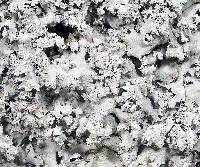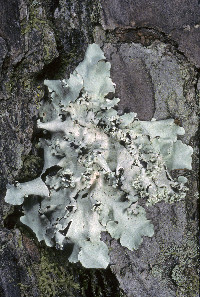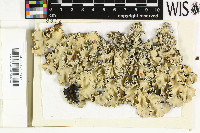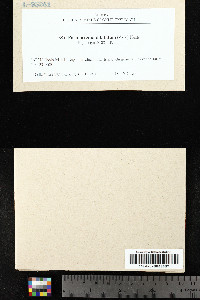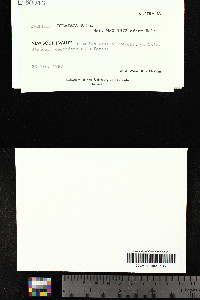
- Home
- Search
- Images
- Species Checklists
- US States: O-Z >
- US National Parks
- Central America
- South America
- US National Parks
- Southern Subpolar Region
|
|
|
|
Family: Parmeliaceae
[Parmelia dilatata Vain.] |
MycoBank no. 343038 Type: Brazil. Minas Gerais: Sítio [nowadays Antônio Carlos], Vainio, E.A. Lich. Bras. Exs. 397 (TUR-V 2548 – holotype, BM, FH, M, UPS – isotypes, fide Hale 1965). Description. Thallus saxicolous; upper surface whitish gray to bright white, shiny, epruinose, emaculate, not cracked; densely lobulate, lobules breaking apart into cauliflower-like soralia with granular coarse soredia (these may sometimes be lacking, see comments below); lobes small to moderate-sized, 2–7 mm wide, ± rotund, eciliate, distinctly delimited along the lobe edge by a conspicuous black rim; lower surface with a ± narrow, deep brown, erhizinate, ~ 1–2.5 mm wide margin, blackening and rhizinate towards the thallus center; rhizines short, stout, black, mostly simple, rarely sparsely branched; medulla white. Apothecia and pycnidia not observed among the Galapagos specimens. Chemistry. Cortex with atranorin [P+ yellow, K+ yellow, KC–, C–, UV–]; medulla with protocetraric and echinocarpic acid [P+ yellow turning orange, K+ dirty yellowish brown, KC+ rosé to orange, C–, UV–]. Ecology and distribution. Africa, Australia, India, North, Central and South America, New Zealand (Hale 1965; Elix 1994; Egan et al. 2016). First reported from Galapagos by Weber (1986), subsequently by Elix & McCarthy (1998) and online (Bungartz et al. 2016). A rare species, typically found on sunny, wind- and rain-exposed rock (one specimen on bark of the hardwood tree Acacia). Specimens that are fertile only, not producing soredia, are treated here as P. eborinum; these fertile exemplars generally appear to be more common in the transition zone, whereas P. dilatatum s.str. may be restricted to the dry zone. Parmotrema weberi is morphologically extremely similar, but chemically distinct; it is generally more common than both P. dilatatum and P. eborinum. Notes. The circumscription of P. dilatatum is still problematic and the descriptions in the literature are inconsistent. Quite possibly the name is being used for different species that share similar habitats, morphology and chemistry (Benatti & Marcelli 2010). The species has been reported from a large geographic area (see ecology and distribution above), and several authors have reported that it contains usnic acid (Hale 1965; Winnem 1975 – the isotype; Swinscow & Krog 1988; Elix 1994; Eliasaro 2001; Donha 2005; Benatti & Marcelli 2010; Egan et al. 2016). Some of these authors (e.g., Benatti & Marcelli (2010) cite only corticolous specimens with usnic acid. All Galapagos specimens are saxicolous, however, and not one of the specimens analyzed contains usnic acid. Without examining a broader range of material from different regions of the world, it is, at this stage, not possible to ascertain whether the Galapagos records refer to P. dilatatum s.str. Nevertheless, all specimens of P. dilatatum cited are clearly distinct from both P. weberi and P. eborinum. We did observe Nash, T.H., Ryan, B.D., Gries, C., Bungartz, F., (eds.) 2002. Lichen Flora of the Greater Sonoran Desert Region. Vol 1. Thallus: foliose, adnate to loosely adnate, 3-20 cm in diam., lobate lobes: subirregular, elongate, slightly imbricate, plane, separate, 10-20 mm wide; apices: rotund, eciliate or short cilia developing in the axils of the lobes upper surface: gray with some blackened areas, smooth, usually shiny, emaculate to faintly white maculate, reticulately cracked with age soredia: granular, common, marginal, in linear soralia that sometimes develop on marginal lacinae; isidia and pustulae: absent medulla: white or pigmented pale yellowish pink, with continuous algal layer lower surface: black with brown to mottled ivory naked zone peripherally, centrally rhizinate; rhizines: scattered, simple Apothecia: rare, substipitate, up to 10 mm in diam.; margin: sparsely sorediate; disc: brown, imperforate ascospores: ellipsoid, 18-22 x 8-10 µm Pycnidia: not seen Spot tests: upper cortex K+ yellow, C-, KC-, P-; medulla K-, C-, KC-, P+ red Secondary metabolites: upper cortex with atranorin and chloroatranorin; medulla with protocetraric acid (major), echinocarpic and conechinocarpic acids (minor or trace), secalonic acid A (+ trace). Substrate and ecology: usually on trees in open habitats, rarely on rocks World distribution: pantropical and SE USA and SW Europe Sonoran distribution: Sinaloa, in the Sierra Madre Occidental. |
|
|
|




